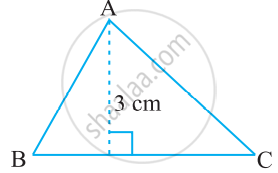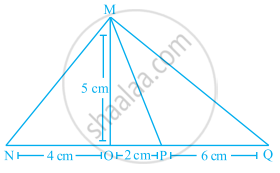Advertisements
Advertisements
प्रश्न
Let ∆ = `|("A"x, x^2, 1),("B"y, y^2, 1),("C"z, z^2, 1)|`and ∆1 = `|("A", "B", "C"),(x, y, z),(zy, zx, xy)|`, then ______.
विकल्प
∆1 = – ∆
∆ ≠ ∆1
∆ – ∆1 = 0
None of these
उत्तर
Let ∆ = `|("A"x, x^2, 1),("B"y, y^2, 1),("C"z, z^2, 1)|`and ∆1 = `|("A", "B", "C"),(x, y, z),(zy, zx, xy)|`, then ∆ – ∆1 = 0.
Explanation:
∆1 = `|("A", "B", "C"),(x, y, z),(zy, zx, xy)|`
= `|("A", x, yz),("B", y, zx),("C", z, xy)|`
= `1/(xyz) |("A"x, x^2, xyz),("B"y, y^2, xyz),("C"z, z^2, xyz)|`
= `(xyz)/(xyz)|("A"x, x^2, 1),("B"y, y^2, 1),("C"z, z^2, 1)|`
= ∆
APPEARS IN
संबंधित प्रश्न
Find the values of k so that the area of the triangle with vertices (1, -1), (-4, 2k) and (-k, -5) is 24 sq. units.
If A(−4, 8), B(−3, −4), C(0, −5) and D(5, 6) are the vertices of a quadrilateral ABCD, find its area.
Find the area of the triangle whose vertices are: (2, 3), (-1, 0), (2, -4)
Find values of k if area of triangle is 4 square units and vertices are (−2, 0), (0, 4), (0, k)
Find the area of a triangle whose vertices are
(6,3), (-3,5) and (4,2)
Show that the following sets of points are collinear.
(2, 5), (4, 6) and (8, 8)
Show that the following sets of points are collinear.
(1, −1), (2, 1) and (4, 5)
Prove that the points (a, b), (a1, b1) and (a −a1, b −b1) are collinear if ab1 = a1b.
Two vertices of a triangle are (1, 2), (3, 5) and its centroid is at the origin. Find the coordinates of the third vertex.
Find the angle subtended at the origin by the line segment whose end points are (0, 100) and (10, 0).
Prove that the lines joining the middle points of the opposite sides of a quadrilateral and the join of the middle points of its diagonals meet in a point and bisect one another
If G be the centroid of a triangle ABC and P be any other point in the plane, prove that PA2+ PB2 + PC2 = GA2 + GB2 + GC2 + 3GP2.
If G(-2, 1) is the centroid of a ΔABC and two of its vertices are A(1, -6) and B(-5, 2) , find the third vertex of the triangle.
Find the area of ΔABC whose vertices are:
A(10,-6) , B (2,5) and C(-1,-3)
Show that the following points are collinear:
A(-5,1), B(5, 5) and C(10, 7)
For what value of x are the points A(-3, 12), B(7, 6) and C(x, 9) collinear.
Prove that the points A (a,0), B( 0,b) and C (1,1) are collinear, if `( 1/a+1/b) =1`.
Find the value(s) of p for which the points (3p + 1, p), (p + 2, p – 5) and (p + 1, –p) are collinear ?
If the points A (x, y), B (3, 6) and C (−3, 4) are collinear, show that x − 3y + 15 = 0.
Using determinants, find the values of k, if the area of triangle with vertices (–2, 0), (0, 4) and (0, k) is 4 square units.
Find BC, if the area of the triangle ABC is 36 cm2 and the height AD is 3 cm.

If Δ = `|(1, x, x^2),(1, y, y^2),(1, z, z^2)|`, Δ1 = `|(1, 1, 1),(yz, zx, xy),(x, y, z)|`, then prove that ∆ + ∆1 = 0.
Let `Delta = abs (("x", "y", "z"),("x"^2, "y"^2, "z"^2),("x"^3, "y"^3, "z"^3)),` then the value of `Delta` is ____________.
Points A(–6, 10), B(–4, 6) and C(3, –8) are collinear such that AB = `2/9` AC.
Find the value of m if the points (5, 1), (–2, –3) and (8, 2m) are collinear.
Ratio of areas of ∆MNO, ∆MOP and ∆MPQ in the given figure is ______.

In the given figure, if PR = 12 cm, QR = 6 cm and PL = 8 cm, then QM is ______.

Area of a right-angled triangle is 30 cm2. If its smallest side is 5 cm, then its hypotenuse is ______.
If area of a triangular piece of cardboard is 90 cm2, then the length of altitude corresponding to 20 cm long base is ______ cm.
Triangles having the same base have equal area.
